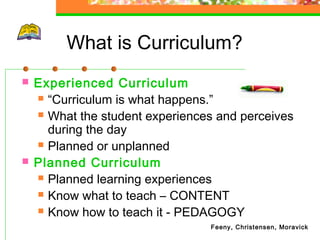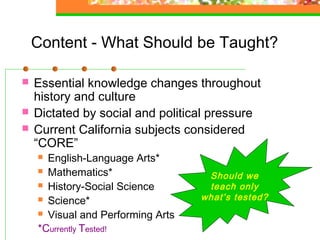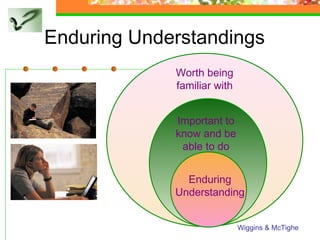Curriculum
- 3. Three Elements of Curriculum “WHO?” The Learner “WHAT?” The Content Subject Matter “HOW?” The Process of Instruction Kinds of Planned Learning Opportunities WHO? WHAT? HOW? From “Who Am I in the Lives of Children?” Feeny, Christensen, Moravick
- 4. Based on Vision of Society Vision translated into Learning Experiences What do you believe is worth knowing? What do you know about the learners and their development? What do you know about subject matter? Feeny, Christensen, Moravick
- 5. Educational Pendulum Is emphasis on nature and interests of the learner? OR Is emphasis on the subject matter to be taught? Importance for you as an educator Stand firm for what you believe in Emphasize developmentally appropriate practice Today’s backlash shifts focus to less student- sensitive practice Feeny, Christensen, Moravick
- 6. What is Curriculum? Experienced Curriculum “Curriculum is what happens.” What the student experiences and perceives during the day Planned or unplanned Planned Curriculum Planned learning experiences Know what to teach – CONTENT Know how to teach it - PEDAGOGY Feeny, Christensen, Moravick
- 7. Content - What Should be Taught? Essential knowledge changes throughout history and culture Dictated by social and political pressure Current California subjects considered “CORE” English-Language Arts* Mathematics* History-Social Science Science* Visual and Performing Arts *Currently Tested! Should we teach only what’s tested?
- 8. Curriculum is Product of Time Influenced by social and political forces Early 20th century European immigrants arrived Emphasized acquisition of American language, customs, values Today’s curriculum Mirrors cultural diversity of current society Reflects importance of families and culture in children’s learning Echoes concerns with violence and values Feeny, Christensen, Moravick
- 9. Plato’s Academy Recommended Course of Study “The exact sciences would first be studied for ten years to familiarise the mind with relations that can only be apprehended by thought.” Arithmetic Plane and solid geometry Astronomy Harmonics Five years would then be given to the still severer study of dialectic - the art of conversation, of question and answer. According to Plato, “dialectical skill is the ability to pose and answer questions about the essences of things. “The dialectician replaces hypotheses with secure knowledge, and his aim is to ground all science, all knowledge, on some 'un-hypothetical first principle'.” Different CORE Curriculum and Instructional Strategies
- 10. John Dewey - 1897 “If education is life, all life has, from the outset, a scientific aspect, an aspect of art and culture, and an aspect of communication. It cannot, therefore, be true that the proper studies for one grade are mere reading and writing, and that at a later grade, reading, or literature, or science, may be introduced. The progress is not in the succession of studies but in the development of new attitudes towards, and new interests in, experience.” Science Art and Culture Communication
- 11. Progressive Education of the Early 20th Century Philosophy and Education are identical, both involving the practical, experimental attempt to improve the human condition. Major impact on the concept of the democratic American education ideal. Views the mind as a problem solver. People are naturally exploring, inquiring entities and learn through direct experience. Student must master the scientific method.
- 12. Education for Democracy Value of knowledge resides in the ability to solve human problems. Subject matter provides information and methodologies for finding solutions. The teacher is an intellectual guide or facilitator in the problem solving process. School is a democratic society in itself, preparing students for community life. Group activities and group problem solving to prepare for solving world problems.
- 13. What knowledge is important today? “If knowledge doubles every year or two, we certainly cannot multiply the number of hours or teach twice as quickly. Some choice, some decisions about what can be omitted, is essential.” The first dilemma: What should be taught? Howard Gardner – 2001 From Multiple Intelligences after Twenty Years http://www.pz.harvard.edu/PIs/HG_MI_after_20_years.pdf
- 14. Howard Gardner What should be highlighted: facts, information? data? If so, which of the countless facts that exist? Subject matters and disciplines--if so, which ones? Which science, which history? Should we nurture creativity, critical thinking? If there is to be an additional focus, should it be arts, technology, a social focus, a moral focus? If you try to have all of these foci, you would break the backs of students and teachers, even given a demanding elementary and secondary school curriculum. (2001)
- 15. The Invention of Education Howard Gardner (2001) One of the most magnificent of human inventions is the Invention of Education--no other species educates its young as do we. At this time of great change, we must remember the ancient value of education and preserve it— Not just facts, data, information, but Knowledge, Understanding, Judgment, Wisdom. We must use the ancient arts and crafts of education to prepare youngsters for a world that natural evolution could not anticipate and which even we ourselves as conscious beings cannot fully envision either.
- 16. Global Responsibility “As the events of the last century remind us, a Dark Age can always descend upon us.” In the past, we could be satisfied with an education that: was based on the literacies that surveyed the major disciplines taught students about their own national culture For our students’ futures we now must: Prepare our students for interdisciplinary work Prepare our students for life in a global civilization. Keep alive the important values of Responsibility and Humanity Gardner (2001)
- 17. Curriculum: What do we teach? Recommended Curriculum Standards as defined by experts in their field Written Curriculum State standards and frameworks, local goals and objectives Supported Curriculum Available materials Textbooks and software
- 18. Curriculum Content in California? Standards: What students need to know and be able to do http://www.cde.ca.gov/be/st/ss/index.asp Frameworks: Provide guidance for implementing the standards adopted by the State Board of Education http://www.cde.ca.gov/ci/cr/cf/allfwks.asp
- 19. Curriculum Planning Process What standards will you be meeting in this unit? How will your learning objectives connect to overall curriculum content standards? What are the essential questions you want students to grapple with in this process? What enduring understandings do you want students to gain?
- 20. Essential Questions and Curriculum Planning Focus on a broad topic of study Have multiple answers and perspectives Address “why” or “how” Help students see the “big picture” Answering such questions may take a lifetime! Answers may only be tentative Information gathering may take place outside of formal learning environments Engage students in real life applied problem solving Essential questions lend themselves to multidisciplinary investigations. Wiggins & McTighe
- 21. Essential Questions Spark students’ curiosity and sense of wonder Desire to understand Something that matters to them Answers to essential questions can NOT be found Students must construct own answers Make their own meaning from information they have gathered Create insight Answering essential questions can lead to “enduring understandings.” Wiggins & McTighe
- 22. Enduring Understandings Worth being familiar with Important to know and be able to do Enduring Understanding Wiggins & McTighe
- 23. The Big Picture Big Ideas Core concepts Focusing themes On-going debates/issues Insightful perspectives Illuminating paradox/problem Organizing theory Overarching principle Underlying assumption Enduring Understanding s Wiggins & McTighe
- 24. Curriculum Planning for Enduring Understandings How will you know that students learned what you expected them to learn? What types of assessment might be most reliable in determining student understanding or level of proficiency? What kinds of activities will result in students being able to develop those skills and gain understanding? What skills do your students need to develop in order to gain enduring understanding? How will you motivate students to think critically and explore essential questions? How will you engage your students in this topic? How do you hook them in with your “anticipatory set”?
- 25. Understanding by Design: Backwards Design Desired Results: What will the student learn? Acceptable Evidence: How will you design an assessment that accurately determines if the student learned what he/she was supposed to learn? Lesson Planning: How do you design a lesson that results in student learning? Identify Desired Results Determine Acceptable Evidence Plan learning experiences and instruction Wiggins & McTighe
- 26. Identify Desired Results and Determine Acceptable Evidence Designing your Assessment Desired Results: What will students say or do to show you objectives were met? (presentation, debate, research paper, essay, etc.) Acceptable Evidence: What will you collect to show student’s learning? (papers, portfolios, observations, work samples, photographs, videos, etc.) Assessments are the products or performances that demonstrate student learning Assessments are what the student does (the actual product or performance), not the evaluation tool used to assess the product.
- 27. Planning Instruction How do you plan your lessons? Backwards Design to Lesson Planning How will you measure student learning? What is the overall purpose of the lesson? Who will participate? What content standard will be met? What are your learning objectives? What are the activities that will get you there? How can you engage students and keep them motivated?
- 28. Planning Instruction What do you need to teach this unit? Materials Space Time Resources What do you do? How? When? Introduction – How do you get them interested? Procedure – What will you do and say (step-by-step guide) Closure – How will you help students make a transition to the next activity?
- 29. Skills and Learning Objectives What skills do students need prior to this lesson or unit of study? How will you scaffold your students and tap into their own prior knowledge? What skills should students gain as a result of this lesson? What key abilities and processes will students develop related to specific content? Write skills as action verbs that are measurable through assessment. http://www.sd104.s-cook.k12.il.us/ppt
- 30. Writing Measurable Instructional Objectives Instructional objectives connect instructional planning with curriculum content as measured by assessment. By participating in this activity students will: Learn about…? Gain greater understanding of…? Practice…? Develop an awareness of…? Express understanding of…? Develop skill in…? Begin to be able to… How will you measure learning outcomes?
- 31. Reflective Practice How will your assessment guide your teaching practice? Was your instruction effective in promoting student learning? What might need to be “re-taught”? How can you teach it differently when assessment demonstrates that some students did not learn the material? Is there a better way to teach this material? What will you do differently next time? How could you extend this activity for another lesson?
- 32. Resources Curriculum 21 - http://www.curriculum21.com/home Dr. Heidi Hayes Jacobs, Mapping The Big Picture (introductory chapters) - http://www.ascd.org/publications/books/197135.aspx Curriculum 101: Janet Hale - http://www.curriculummapping101.com/ Dr. Janet Hale - http://www.21- learn.com/teamtarget/ProfessionalDevelopment/curr_m ap_hale/index.htm Understanding by Design Website - http://www.ubdexchange.org/
































